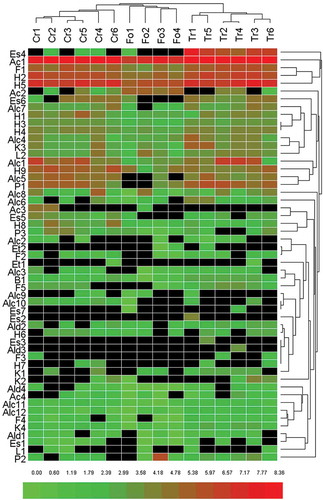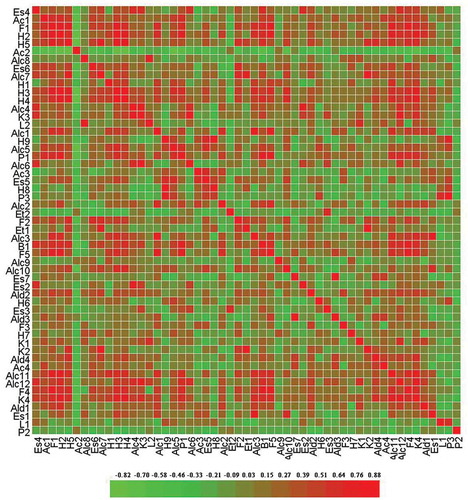ABSTRACT
The volatile composition of cocoa from 16 accessions covering three different morphogenetic groups, namely, Criollo, Forastero, and Trinitario, was investigated. Fifty-three compounds were profiled using HS-SPME-GC-MS, and the number of volatiles per accession was found to be significantly associated with the morphogenetic groups. Volatile assemblages differed significantly among Criollo, Forastero, and Trinitario groups (ANOSIM, R = 0.715, p = 0.001). The differences in the volatile compounds of the three morphogenetic groups were essentially quantitative, and only a few compounds were found exclusively specific to a certain group, mainly in Trinitario. Moreover, the volatile compounds differed from these morphogenetic groups, which revealed complex interactions between them, including participation in the same biosynthetic pathways. Principal component analysis revealed that Trinitario cocoa had high contents of furfuryl alcohol, 3-carene, 2-pentanol, 1-pentanol, 2,3-butanediol, 2-heptanol, and benzyl acetate. Criollo cocoa contained high amounts of α-limonene, β-caryophyllene, β-myrcene, α-phellandrene, β-linalool, and acetic acid. Forastero cocoa also exhibited high contents of 3-methylbutanoic acid, 2-(2-butoxyethoxy) ethanol, anethole, and 2,4-pentanediol. However, the volatile compound pattern detected in Forastero cocoa was inconsistent. Volatile profiling of cocoa by HS-SPME-GC-MS and the interrelationship detected among the volatiles can be used as a roadmap for future breeding or biotechnological applications.
Introduction
Cocoa (Theobroma cacao L.), commonly known as the chocolate tree, belongs to genus Theobroma family Malvaceae. This economic tropical tree crop, which is native to the lowland rainforests of the Amazon basin, is cultivated by 5–6 million smallholder farmers in Central and South Americas, Caribbean, Africa, Asia, and some Pacific Islands.[Citation1] Cocoa beans comprise the major raw material for the chocolate industry, with an annual production of approximately 4.6 million tons.[Citation2,Citation3] Aside from not being able to make chocolate without cocoa beans, the distinctive flavor of chocolate is ascribed to these beans. Commercial cocoa traders typically separate cocoa beans into bulk and fine cocoa types, with fine cocoa characterized by the special floral and fruity aroma notes, which are absent in bulk cocoa. Mainly three morphogenetic groups of cocoa beans are produced worldwide: Forastero (bulk grade), Criollo (fine grade), and their hybrid, Trinitario (fine grade).[Citation4–Citation6] However, all major commercial-related activities over the past five decades have involved bulk cocoa. The market share of fine cocoa is less than 5% of the world trade per annum, and only few cocoa cultivars, such as arriba nacional from Ecuador and pure nacional from Peru, are suited to produce fine-flavor chocolate.[Citation7] New and unique fine cocoa flavor sources are in demand by global fine-flavor chocolate industries.
Numerous studies have already been conducted to detect the compositions of aromatic volatile compounds released by cocoa beans.[Citation8–Citation10] This information is a prerequisite to evaluate the volatile biosynthetic pathways, as well as to identify the genetic and environmental effects in volatile composition.[Citation11] To date, more than a hundred different volatile compounds have been identified on the basis of fermentation, drying processes, and harvest maturity.[Citation12–Citation19] Cocoa bean fermentation and drying contribute to developing cocoa-chocolate flavors by increasing levels of amino acids and sugars.[Citation4] The levels of cocoa volatile compounds formed during roasting are shown to vary directly with bean fermentation time.[Citation4,Citation14] In addition, Guehi et al.[Citation12] reported that dried fermented cocoa beans contain higher acidity (higher levels of lactic and acetic acids) than unfermented cocoa beans. As far as other postharvest processes are concerned, cocoa bean roasting leads to higher levels of pyrazines in well-fermented beans than in less-fermented or unfermented beans.[Citation10]
Nevertheless, the available fragmented information together with the different techniques in chocolate production (fermentation, drying, roasting, and conching) caused difficulties in the comparison of aromatic volatile compounds among different cocoa genetic types present in the literature.[Citation7,Citation8,Citation20] Importantly, recent studies have concluded that aroma is specific to cultivars, such as CCN51, EET62, and SCA6, and exhibits a unique potential flavor characteristic.[Citation21,Citation22] In contrast to drying, roasting, or fermentation processes, no studies have been performed for the volatiles in the three morphogenetic groups, namely Criollo, Forastero, and Trinitario. Moreover, the volatile compounds of the three cocoa groups serve as indicators to differentiate fine from bulk cocoa and determine the quality of fine cocoa. Therefore, the current study investigated the differences in volatile profiles among the groups of Criollo, Forastero, and Trinitario cocoa beans to evaluate the volatile polymorphism of different cocoa morphogenetic groups and thus generate aroma information for future breeding or biotechnological applications.
Materials and methods
Plant materials
In this study, 16 cocoa accessions representing three major morphogenetic groups of cocoa, namely Criollo, Forastero, and Trinitario, were evaluated for the composition and concentration of their volatile compounds (). Cocoa pods were obtained from the Cocoa Germplasm Repository of the Spice and Beverage Research Institute, CATAS, Hainan Province, China, in the major season (March to May) of 2014. All cocoa accessions are under the standard management scheme with normal pruning, irrigation, and fertilization. Healthy cocoa pods at commercial mature stage were harvested from three trees of each accession. Ten or Fifteen cocoa pods from different positions of one tree were mixed and considered as one replication. All cocoa pods were picked from the tree trunk approximately 100–150 cm high above the ground. After harvest, samples were taken to the laboratory immediately. Cocoa seeds were collected, unfermented, and sun-dried at a temperature of 50 ± 2°C. The sun-drying process was done by placing cocoa on coir matting, which was placed on a concrete floor in 15-cm thick layers. Afterward, the beans were mixed manually every day for 5–7 days to obtain 5–7% moisture. Samples of 2 kg each from dried cocoa beans were taken randomly. Each sample was subsequently fractioned into two parts: one of which was manually separated from testa to obtain the cocoa beans. The cocoa beans were ground with a pestle and mortar until to obtain cocoa flour and analyzed for volatile compounds. The other one cocoa bean sample was immediately stored under −40 ± 2°C.
Table 1. 16 cocoa accessions representing three morphogenetic groups, Criollo, Forastero, and Trinitario, used in this study (mean ± SE).
Extraction of volatile compounds
The solid-phase microextraction in the headspace (HS-SPME) method was used to extract the volatile compounds and evaluate the concentrations. For headspace sampling, the assayed fibers used in this study were DVB-CAR-PDMS with 50/30 μm film thickness (Supelco, Bellefonte, PA, USA), which was preconditioned at 250°C for 30 min in the GC injector, following the literature[Citation13] and preliminary tests. For each extraction sample, 0.60 g of sodium chloride and 1 μl of internal standard (0.814 g·ml−1 3-octanol) were added to 2.00 g of cocoa flour and placed in a 15-ml capped SPME vial. The vial was subsequently placed in a 60°C water bath with a magnetic stirrer to maintain constant temperature, and the SPME fiber was exposed to the headspace testing sample to absorb the analytes for 30 min. The SPME fiber was then introduced into a preheated injector port of the GC for sample desorption at 250°C for 5 min in splitless mode. Linear retention indices (LRIs) were determined on the basis of the alkane series (C7–C30).
GC-MS conditions
An HP-7890A/5975C GC-MS system (Agilent Technologies, Wilmington, USA), along with a DB-WAX column system (20 m × 0.18 mm I.D. × 0.18 μm microns, Agilent Technologies), was used under the following conditions: 250°C for MS transfer line heater, 250°C for injector temperature, and operation conducted in splitless mode. Initial oven temperature was set at 40°C for 5 min. The following program profiles were then used: from 40°C to 180°C at 4°C·min−1, from 180°C to 260°C at 10°C·min−1, and maintained for 2 min at 250°C. Helium gas was used as a carrier gas at a flow rate of 1.0 mL·min−1. An Agilent 5975C MS was operated in the electron ionization mode at 70 eV with source temperature of 230°C. A quadrupole was set at 150°C, and a scan was set from an m/z 30 to 500 in full-scan mode. Volatile compounds were identified according to their LRIs and by comparing their mass spectra with the MS database via the NIST 2008 library, Volatile Compounds in Food 15.1, and Pherobase (database of pheromones and semi-chemicals).
Statistical analysis
Kruskal–Wallis test was performed to determine the significant differences in the number of volatile compounds among cocoa accessions of the different morphogenetic groups, namely Criollo, Forastero, and Trinitario. One-way ANOVA was performed to test the variation of volatile concentrations among the different cocoa morphogenetic groups (p < 0.05). Bray–Curtis similarity test was performed to examine the volatile compositional similarity of the different cocoa accessions. A nonparametric two-way analysis of similarity (ANOSIM) was performed to test the significant differences in volatile composition among the cocoa accessions. Additionally, volatile compounds identified from cocoa seeds at the morphogenetic level were analyzed by principal component analysis (PCA). PCA was conducted using R package version 2.12.2 for Windows.
Results and discussion
Variation of volatile compounds in three cocoa morphogenetic groups
lists the volatile compounds identified in our HS-SPME-GC-MS platform and the relative levels for the analyzed three cocoa morphogenetic groups, namely Criollo, Forastero, and Trinitario. The volatile compounds in the Criollo, Forastero, and Trinitario groups were very diverse. A total of 53 volatile compounds have been identified: 12 alcohols, 9 hydrocarbons, 7 esters, 5 furans, 4 acids, 4 aldehydes, 4 ketones, 3 phenols, 2 ethers, 2 lactones, and 1 base. According to Magi et al.[Citation23] and Rodriguez-Campos et al.,[Citation13,Citation14] the total profile of the volatile compounds in the three cocoa morphogenetic groups revealed the predominance of acids, alcohols, hydrocarbons, esters, and furans. Chemical classes commonly existing in three cocoa morphogenetic groups were also identified as follows: 2,3-butanediol, acetic acid, 2-pentanol, 2-heptanol, 2-acetylpyrrole, furfural, β-pinene, 3-carene, β-myrcene, α-limonene, β-caryophyllene, 2-nonanone, and γ-butyrolactone with a mean of 37.50 compounds per accession (n = 16, range 32–42). The Trinitario cocoa group exhibited the highest volatile compound diversity (mean = 39.32 ± 0.63, n = 6), followed by the Criollo group (mean = 37.67 ± 0.87, n = 6) (). Forastero group showed the lowest volatile compound diversity (mean = 33.75 ± 0.71, n = 4), which was significantly different from those of the Trinitario (χ2 = 6.63, df = 1, p = 0.010) and Criollo cocoas (χ2 = 5.04, df = 1, p = 0.025). However, the number of volatile compounds varied between the groups of Trinitario and Criollo cocoas, with only a marginal significance (Kruskal–Wallis test, χ2 = 2.92, df = 1, p = 0.088).
Table 2. Volatile compounds (μg·kg−1 FW equivalent of 3-octanol) detected in Criollo, Forastero, and Trinitario cocoa groups belong to different chemical classes (mean ± SE).
Figure 1. Range and distribution of total volatiles among three morphogenetic groups of cocoa. Box plot extremities show the 25th and 75th percentiles; the Whiskers represent the 5th and 95th percentiles; the horizontal bar represents the median value; crosses indicate mean value; and points are outliers. “Cr,” “Fo,” and “Tr” represent Criollo, Forastero, and Trinitario cocoa, respectively.
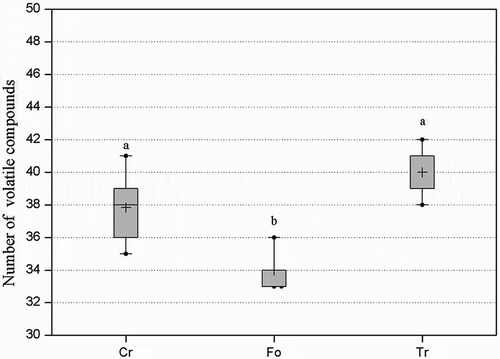
Compositional similarities of volatile assemblages in three cocoa morphogenetic groups
Volatile assemblages differed considerably among the morphogenetic groups of Criollo, Forastero, and Trinitario (ANOSIM, R = 0.715, p = 0.001). On average, cocoa accessions within the same morphogenetic group tend to achieve a lower Bray–Curtis similarity among each other (mean = 66.38%, CV = 20.51, n = 120 comparisons); this pattern indicated higher diversity in volatile compounds at the genetic level. Volatile compositions of the Trinitario group showed the highest similarity (mean = 79.70%, CV = 4.11, n = 15) (). The average Bray–Curtis similarity of the Forastero cocoa volatile compounds was lower (mean = 70.39%, CV = 11.46, n = 6) than that of the Trinitario or Criollo groups, and significant differences were detected among the accessions in Trinitario (ANOSIM, R = 0.996, p = 0.004) and Criollo (ANOSIM, R = 0.984, p = 0.008) groups.
Figure 2. Bray–Curtis similarity distributions among three morphogenetic groups of cocoa. Box plot extremities show the 25th and 75th percentiles; the Whiskers represent the 5th and 95th percentiles; the horizontal bar indicates the median value; crosses indicate the mean value; and points represent outliers. “Cr,” “Fo,” and “Tr” represent Criollo, Forastero, and Trinitario cocoa, respectively.
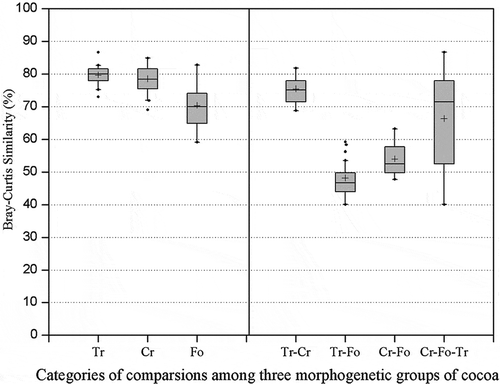
Differences in contents of volatile compounds among the three cocoa morphogenetic groups
The composition and content of volatiles in Criollo, Forastero, and Trinitario groups varied significantly (). Acids are considered to be key contributors to cocoa flavor, specifically the acidification of cocoa beans by acetic acid during fermentation processes, leading to various biochemical modifications necessary for cocoa flavor development.[Citation24,Citation25] Acids were the most abundant volatiles in these cocoa groups (), which contributed 30.42–40.81% of the total volatile content. Acid compound content was significantly higher in Trinitario cocoa (414.70 ± 29.45 μg·kg−1 FW) and Criollo cocoa (389.17 ± 29.19 μg·kg−1 FW) than those in Forastero cocoa (224.20 ± 27.40 μg·kg−1 FW). Four acids were identified in these cocoa groups. Krysiak et al.[Citation25] reported that acetic acid was the most abundant volatile acid (~37%) in unfermented cocoa beans, and it has been described to exhibit a “sour, vinegar-like” aroma.[Citation19] Some studies suggested that chocolates produced from Criollo beans have higher acidic tones, related to acetic acid, compared to Forastero and Trinitario beans.[Citation26,Citation27] In the current study, the most abundant acetic acid compound was found in Trinitario cocoa (402.23 ± 24.55 μg·kg−1 FW), followed by Criollo cocoa (365.80 ± 33.54 μg·kg−1 FW). However, the acetic acid content of Forastero cocoa was very low, with a mean content of 180.73 ± 29.39 μg·kg−1 FW.
Figure 3. Average contents of volatile groups (μg·kg−1 FW equivalent of 3-octanol) in Criollo, Forastero, and Trinitario cocoa. Significance values of volatile content differences among the three cocoa groups are indicated by small letters (p < 0.05).
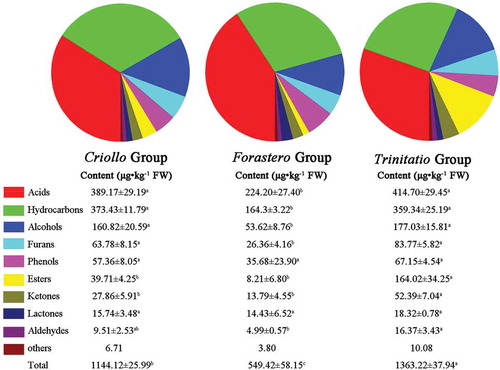
Alcohols are typically described to have “fruity and plant-like” notes.[Citation28] A total of 12 alcohols were detected in the three cocoa groups. Alcohol content was significantly higher in Trinitario cocoa (177.03 ± 15.81 μg·kg−1 FW) and Criollo cocoa (160.82 ± 20.59 μg·kg−1 FW) than that in Forastero cocoa (53.62 ± 8.76 μg·kg−1 FW). However, a significant difference was also found between Trinitario and Criollo cocoas. Kadow et al.[Citation8] and Oberparlaiter and Ziegleder[Citation29] reported that the most abundant alcohols were 2-pentanol, 2-heptanol, 2-ethyl-1-hexanol, β-linalool, and 2,3-butanediol, which accounted for greater than 80% of the total alcohol-type volatile contents. With regard to individual alcohol content, 2-heptanol, β-linalool, and 2-pentanol are described to have “fruity, lemongrass, and floral” notes, relating to the “floral” note, respectively. They also contribute to the fruity and floral odors in fine cocoa.[Citation6,Citation16] In the current study, the contents of 2-pentanol were significantly higher in Trinitario cocoa (57.92 ± 17.67 μg·kg−1 FW) and Criollo cocoa (49.61 ± 13.92 μg·kg−1 FW) than in Forastero cocoa (12.06 ± 2.47 μg·kg−1 FW). Trinitario and Criollo cocoas were found to have high levels of β-linalool, ranging from 8.21 to 40.63 μg·kg−1 FW; however, the β-linalool content of Forastero cocoa was very low, with a mean content of 4.65 ± 1.57 μg·kg−1 FW.
As major components, aldehydes can result from lipid oxidation or self-oxidation and the degradation of fatty acids.[Citation25] In the present study, the aldehyde compounds of the three cocoa groups contributed 0.83–1.20% to the total volatile content. The sum of the aldehydes was significantly higher in Trinitario cocoa (16.37 ± 3.43 μg·kg−1 FW) than in Forastero cocoa (4.99 ± 0.57 μg·kg−1 FW). Hexanal and nonanal were detected as major aldehyde compounds, which accounted for greater than 70% of the total aldehydes. Hexanal has been described to exhibit a “cut grass-like” aroma,[Citation30,Citation31] and the most abundant hexanal compound was found in Trinitario cocoa (2.69 ± 0.60 μg·kg−1 FW), followed by Criollo cocoa (2.29 ± 0.51 μg·kg−1 FW); Forastero cocoa has the lowest content at 1.05 ± 0.49 μg·kg−1 FW. Nonanal, which contributes a fragrant, woody-like aroma, was also found to be a dominant aldehyde compound in the three cocoa groups.[Citation32] The contents of nonanal were significantly higher in the morphogenetic groups of Trinitario cocoa (7.94 ± 0.54 μg·kg−1 FW) and Criollo cocoa (5.26 ± 1.75 μg·kg−1 FW) than those in Forastero cocoa (2.83 ± 0.94 μg·kg−1 FW).
Esters are important aroma compounds of cocoa, which contribute fruity flavors based on the reaction of organic acids with ethanol.[Citation2] Trinitario cocoa exhibited the highest total ester content at 164.02 ± 34.25 μg·kg−1 FW, followed by Criollo cocoa at 39.71 ± 4.25 μg·kg−1 FW; Forastero cocoa showed the lowest content at 8.21 ± 6.80 μg·kg−1 FW. Furthermore, Trinitario cocoa exhibited the highest benzyl acetate and phenethyl acetate content levels at 123.30 ± 27.94 and 24.61 ± 3.26 μg·kg−1 FW, followed by Criollo cocoa with 2.99 ± 1.34 and 22.06 ± 6.32 μg·kg−1 FW. However, the corresponding contents in Forastero cocoa group were very low, with only 0.84 ± 0.84 and 4.44 ± 4.44 μg·kg−1 FW.
Five furans, namely furancarboxaldehyde (furfural), cis-furan linalool oxide, 2-acetylfuran, 5-methylfurfural, and furfuryl alcohol (furaneol), were found in the present study, which accounted for 4.80%–6.14% of the total volatiles. The total furans in Trinitario cocoa (83.77 ± 5.82 μg·kg−1 FW) and Criollo cocoa (63.78 ± 8.15 μg·kg−1 FW) were significantly higher than those in Forastero cocoa (26.36 ± 4.16 μg·kg−1 FW) although no significant difference was detected between Trinitario and Criollo cocoas. Volatile furan derivatives are very low in unfermented cocoa beans.[Citation25] Most furans, such as furfural and furaneol, were characterized by caramel-like, sweet, and honey notes, which were potential derivatives of Strecker degradation and caramelization reactions developed during cocoa processing and transformation through chocolate flavor synthesis in conching.[Citation2,Citation33,Citation34] In this study, furfural and furaneol were also found to be major furan compounds, accounting for greater than 90% of the total furans. In addition, Trinitario cocoa exhibited the highest furfural and furaneol contents at 63.71 ± 4.91 and 9.73 ± 1.50 μg·kg−1 FW, followed by Criollo cocoa with 50.18 ± 5.40 and 5.80 ± 1.85 μg·kg−1 FW of furfural and furaneol contents. However, the corresponding contents in Forastero cocoa group were very low, with only 23.49 ± 3.14 and 1.10 ± 0.64 μg·kg−1 FW.
Nine hydrocarbons were found, which accounted for 26.35–32.64% of the total volatiles. The total hydrocarbon contents in Trinitario cocoa (359.34 ± 25.19 μg·kg−1 FW) and Criollo cocoa (373.43 ± 11.79 μg·kg−1 FW) were significantly higher than those of in Forastero cocoa (164.3 ± 3.22 μg·kg−1 FW) although no significant difference was detected between Trinitario and Criollo cocoas. Saturated hydrocarbons do not exhibit characteristic odors, but their notes are described as “gassy” or “petrol”.[Citation35] However, certain alkenes have characteristic pleasant odors, such as β-caryophyllene (woody, spicy),[Citation36] β-myrcene (spicy, clove-like),[Citation37] α-limonene (citrus),[Citation38] 3-carene (lemon, resin),[Citation39] and α-phellandrene (dill, medicinal).[Citation40] In this study, 3-carene, β-myrcene, α-limonene, and β-caryophyllene were the major hydrocarbon compounds evaluated, which accounted for greater than 80% of the total hydrocarbons. Trinitario cocoa exhibited the highest α-limonene, 3-carene, β-myrcene, and α-phellandrene contents at 168.52 ± 19.74, 94.61 ± 6.61, 20.35 ± 1.76, and 14.27 ± 0.93 μg·kg−1 FW, respectively, followed by Criollo cocoa with 146.54 ± 8.54, 86.34 ± 8.95, 19.45 ± 1.48, and 13.84 ± 1.06 μg·kg−1 FW, respectively. For Forastero cocoa, the contents of these hydrocarbon compounds (α-limonene, 3-carene, β-myrcene, and α-phellandrene) were very low, with the mean contents of 68.27 ± 4.74, 40.20 ± 4.16, 9.69 ± 1.09, and 7.57 ± 0.56 μg·kg−1 FW, respectively.
Four ketones, three phenols, two lactones, and two ether compounds were detected in the current study. Volatiles such as 2-nonanone (ketones) and γ-butyrolactone (lactones) were described to have a fresh and sweet odor and fruity taste.[Citation7] Trinitario cocoa showed the highest 2-nonanone and γ-butyrolactone contents (29.98 ± 6.53 and 17.43 ± 1.05 μg·kg−1 FW), followed by Criollo cocoa (15.02 ± 3.77 and 14.98 ± 3.65 μg·kg−1 FW); Forastero cocoa exhibited the lowest content of 2-nonanone and γ-butyrolactone at 8.21 ± 2.64 and 14.00 ± 6.14 μg·kg−1 FW. Although the total contents of ketones in Trinitario cocoa (52.39 ± 7.04 μg·kg−1 FW) and Criollo cocoa (27.86 ± 5.91 μg·kg−1 FW) were significantly higher than those in Forastero cocoa (13.79 ± 4.55 μg·kg−1 FW), no significant differences in the total contents of lactones, phenols, and ethers were found among the Trinitario, Criollo, and Forastero cocoas.
Relative abundance of different classes of volatile compounds in three cocoa morphogenetic groups
To further understand the usefulness of the volatile profiles to define and distinguish the three major cocoa groups, a PCA was performed. The first two PCs carried important information and explained approximately 60% of the variance, which clearly differentiated the three groups from one another (). The score scatter plot of PCA of the 11 chemical classes of volatile compounds is shown in , and 53 volatile compounds in the three major cocoa groups are presented in . As illustrated in , Forastero cocoa, which lie in the negative regions of PC1, were clearly differentiated from Trinitario cocoa. Trinitario cocoa (high scores on PC1) combine high contents of furans, alcohols, hydrocarbons, and acids, specifically 2-phenylethanol, 2,3-butanediol, 1-pentanol, 2-pentanol, 2-heptanol, benzyl acetate, 1-phenylethanone, 2-nonanone, furaneol, nonanal, 2-acetylpyrrole, and 3-carene. On the contrary, Forastero cocoa are located in the negative regions of PC1, with higher content levels of 3-methylbutanoic acid, 2-(2-butoxyethoxy) ethanol, anethole, and 2,4-pentanediol. Criollo cocoa was located toward the middle of PC1. Acetic acid, β-caryophyllene, ethyl phenylacetate, 2-ethyl-1-hexanol, α-limonene, α-phellandrene, β-myrcene, phenethyl acetate, β-linalool, α-toluenol, and furfural were strongly correlated with the Criollo cocoa.
Figure 4. Distribution of 11 chemical classes of volatile compounds and 53 volatile compounds in 16 cocoa accessions generated by principal component analysis. (a) Distribution of 11 chemical classes of volatile compounds indicated by black dots. (b) Distribution of 53 volatile compounds in 16 cocoa accessions indicated by light gray dots (numbers correspond to those in ).
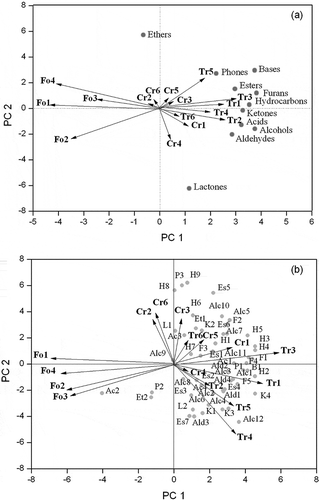
A cluster analysis also confirmed that the three cocoa groups exhibited the most differential volatile profiles (). Clusters of volatile compounds with differential accumulation levels rather than few individual compounds were responsible for the separation among these three morphogenetic groups. A correlation analysis of the volatile compounds was performed to evaluate how these metabolites relate to each other. The volatile compounds of esters showed high positive correlations with alcohol compounds and other structurally similar esters (positive correlations are shown in red in ). The pattern may indicate that the levels of these compounds, which show up to 145-fold variations between groups, can be related to some enzymatic activities, such as those of alcohol acyltransferase.[Citation11] Furthermore, a significant negative correlation between ester and aldehyde levels was observed, and this pattern indicates that alcohol dehydrogenase enzyme activity may participate in the formation of the difference between the levels of volatile compounds among the three cocoa groups.
Conclusion
Volatile composition and content depend largely upon cocoa genetic background. Almost all the characteristic volatiles in Criollo and Trinitario were significantly higher than in Forastero group. Cluster and correlation analyses indicated interesting relationships between compounds and classes of compounds, revealing the existence of interesting interactions between the biosynthetic pathways. Trinitario cocoa was characterized by high contents of furans, hydrocarbons, alcohols, and esters. Moreover, Criollo cocoa had extremely high contents of hydrocarbons, alcohols, and acids. However, Forastero cocoa showed no consistent volatile compound pattern but exhibited high contents of 3-methylbutanoic acid, 2-(2-butoxyethoxy) ethanol, anethole, and 2,4-pentanediol. Volatile profiling of cocoa by HS-SPME-GC-MS has proven to be a highly valuable tool for the characterization of cocoa beans from different morphogenetic groups. The results could be used as a roadmap to guide in the selection process of cocoa breeding programs aimed to obtain new varieties with better aroma and also to monitor industrial processes that may affect aroma.
Funding
This study was partially supported by the Natural Science Foundation of Hainan Province of China (No. 20153153) and the Ministry of Agriculture of the People’s Republic of China (No. 2016NWB050).
Additional information
Funding
References
- Boza, E.J.; Irish, B.M.; Meerow, A.W.; Tondo, C.L.; Rodríguez, O.A.; Ventura-López, M.; Gómez, J.A.; Moore, J.M.; Zhang, D.P.; Motamayor, J.C.; Schnell, R.J. Genetic Diversity, Conservation, and Utilization of Theobroma cacao L.: Genetic Resources in the Dominican Republic. Genetic Resources and Crop Evolution 2012, 60, 609–615.
- Afoakwa, E.O.; Paterson, A.; Fowler, M.; Ryan, A. Flavor Formation and Character in Cocoa and Chocolate: A Critical Review. Critical Reviews in Food Science and Nutrition 2008, 48, 840–857.
- Rimbach, G.; Melchin, M.; Moehring, J.; Wagner, A.E. Polyphenols from Cocoa and Vascular Health-A Critical Review. International Journal of Molecular Sciences 2009, 10, 4290–4309.
- Counet, C.; Ouwerx, C.; Rosoux, D.; Collin, S. Relationship between Procyanidin and Flavor Contents of Cocoa Liquors from Different Origins. Journal of Agricultural and Food Chemistry 2004, 52, 6243–6249.
- Zhang, H.D.; Maharaj, K.; Cronk, Q.C.B. Complex Origin of Trinitario-type Theobroma cacao (Malvaceae) from Trinidad and Tobago Revealed Using Plastid Genomics. Tree Genetics & Genomes 2013, 9, 829–840.
- Motamayor, J.C.; Lachenaud, P.; Mota, J.W.S.; Loor, R.; Kuhn, D.N.; Brown, S.; Schnell, R.J. Geographic and Genetic Population Differentiation of the Amazonian Chocolate Tree (Theobroma cacao L.). PLoS ONE 2008, 3, e3311.
- van der Kooij, S. Market Study of Fine Flavour Cocoa in 11 Selected Countries-Revised Version. Royal Tropical Institute, KIT Development Policy & Practice: Amsterdam, 2013.
- Kadow, D.; Bohlmann, J.; Phillips, W.; Lieberei, R. Identification of Main Fine or Flavour Components in Two Genotypes of the Cocoa Tree (Theobroma cacao L.). Journal of Applied Botany and Food Quality 2013, 86, 90–98.
- Abeygunasekera, D.D.; Mubarak, A.M.; Jansz, E.R. The Volatiles of Cocoa by GC/MS Analysis and Sensory Evaluation with Special Emphasis on the Effect of Fermentation Time and Maturation. Journal of the National Science Council of Sri. Lanka 1989, 17, 229–235.
- Jinap, S.; Wan Rosli, W.I.; Russly, A.R.; Nurdin, L.M. Effect of Roasting Time and Temperature on Volatile Components Profile during Nib Roasting of Cocoa Beans (Theobroma cacao L). Journal of the Science of Food and Agriculture 1998, 77, 441–448.
- González-Mas, M.C.; Rambla, J.L.; Alamar M.C.; Gutiérrez, A.; Granell, A. Comparative Analysis of the Volatile Fraction of Fruit Juice from Different Citrus Species. PLoS ONE 2011, 6, e22016.
- Guehi, T.S.; Zahouli, I.B.; Ban-Koffi, L.; Fae M.A.; Nemlin, J.G. Performance of Different Drying Methods and Their Effects on the Chemical Quality Attributes of Raw Cocoa Material. International Journal of Food Science and Technology 2010, 45, 1564–1571.
- Rodriguez-Campos, J.; Escalona-Buendía, H.B.; Orozco-Avila, I.; Lugo-Cervantes, E.; Jaramillo-Flores, E. Dynamics of Volatile and Non-Volatile Compounds in Cocoa (Theobroma cacao L.) during Fermentation and Drying Processes Using Principal Components Analysis. Food Research International 2011, 44, 250–258.
- Rodriguez-Campos, J.; Escalona-Buendía, H.B.; Contreras-Ramos, S.M.; Orozco-Avila, I.O.; Jaramillo-Flore, E.; Lugo-Cervantes, E. Effect of Fermentation Time and Drying Temperature on Volatile Compounds in Cocoa. Food Chemistry 2012, 132, 277–288.
- Portillo, E.; Labarca, M.; Grazziani, L.; Cros, E.; Assemat, S.; Davrieux, F.; Renaud, B.; Maria, M. Aroma Formation of Criollo Cocoa (Theobroma cacao L.) in Function of the Postharvest Treatment in Venezuela. Revista Científica UDO Agrícola 2009, 9, 458–468.
- Ducki, S.; Miralles-Garcia, J.; Zumné, A.; Tornero, A.; Storey, D.M. Evaluation of Solid-Phase Micro-Extraction Coupled to Gas Chromatography-Mass Spectrometry for the Headspace Analysis of Volatile Compounds in Cocoa Products. Talanta 2008, 74, 1166–1174.
- Afoakwa, E.O. Chocolate Science and Technology; Wiley-Blackwell Publishers: Oxford, UK, 2010; 3–22 pp.
- Monteiro, W.R.; Lopez, U.V.; Clement, D. Genetic Improvement in Cocoa. In Breeding Plantation Tree Crops: Tropical Species; Jain, S.M.; Priyadarshan, D.; Eds.; Springer Science, Business Media, 2009; 589–626.
- Eskes, A.B.; Guarda, D.; Garcia, L.; Garcia, P. Is Genetic Variation for Sensory Traits of Cocoa Pulp Related to Fine Flavor Cocoa Traits? INGENIC Newsletter 2007, 11, 22–28.
- Bailey, S.D.; Mitchell, D.G.; Bazinet, M.L.; Weurman, C. Studies on the Volatile Components of Different Varieties of Cocoa Beans. Journal of Food Science 1962, 27, 165–170.
- Azila, A.K.; Nur Aida, W.A.W. Study on Supercritical Fluid Extraction of Aromatic Compound from Roasted Cocoa Beans Using Multilevel Factorial Design. Turkish Online Journal of Science & Technology 2013, 35, 120–125.
- Krings, U.; Zelena, K.; Wu, S.; Berger, R.G. Thin-Layer High-Vacuum Distillation to Isolate Volatile Flavour Compounds of Cocoa Powder. European Food Research and Technology 2006, 223, 675–681.
- Magi, E.; Bono, L.; Carro, M.D. Characterization of Cocoa Liquors by GC-MS and LC-MS/MS: Focus on Alkylpyrazines and Flavanols. Journal of Mass Spectrometry 2012, 47, 1191–1197.
- Wang, Y.; Juliani, H.R.; Simon, J.E.; Ho, C.T. Amino Acid-Dependent Formation Pathways of 2-acetylfuran and 2,5-Dimethyl-4-hydroxy-3[2H]-furanone in the Maillard Reaction. Food Chemistry 2009, 115, 233–237.
- Krysiak, W.; Majda, T.; Nebesny, E. An Effect of Relative Air Humidity on the Content of Volatile Compounds in Roasting Cocoa Beans. In Focus on Food Engineering Research and Development; Vivian, N.P.; Eds.; Nova Science, Inc., 2007; 467–482.
- Frauendorfer, F.; Schieberle, P. Changes in Key Aroma Compounds of Criollo Cocoa Beans during Roasting. Journal of Agricultural and Food Chemistry 2008, 56, 10244–10251.
- Acierno, V.; Yener, S.; Alewijn, M.; Biasioli, F.; Ruth, S. Factors Contributing to the Variation in the Volatile Composition of Chocolate: Botanical and Geographical Origins of the Cocoa Beans, and Brand-Related Formulation and Processing. Food Research International 2016, 84, 86–95.
- Saltini, R.; Akkerman, R.; Frosch, S. Optimizing Chocolate Production through Traceability: A Review of the Influence of Farming Practices on Cocoa Bean Quality. Food Control 2013, 29, 167–187.
- Oberparlaiter, S.; Ziegleder, G. Amyl Alcohols as Compounds Indicative of Raw Cocoa Bean Quality. Zeitschrjft Lebensmittel Untersuchung und Forschung A 1997, 204, 156–160.
- Schnermann, P.; Schieberle, P. Evaluation of Key Odorants in Milk Chocolate and Cocoa Mass by Aroma Extract Dilution Analyses. Journal of Agricultural and Food Chemistry 1997, 45, 867–872.
- Chai, Q.Q.; Wu, B.H.; Liu, W.S.; Wang, L.J.; Yang, C.X.; Wang, Y.J.; Fang, J.B.; Liu, Y.C.; Li, S.H. Volatiles of Plums Evaluated by HS-SPME with GC-MS at the Germplasm Level. Food Chemistry 2012, 130, 432–440.
- Liu, J.B.; Liu, M.Y.; He, C.C.; Song, H.L.; Guo, J.; Wang, Y.; Yang, H.Y.; Su, X.X. A Comparative Study of Aroma-Active Compounds between Dark and Milk Chocolate: Relationship to Sensory Perception. Journal of the Science of Food and Agriculture 2014, 95, 1362–1372.
- Afoakwa, E.O.; Paterson, A.; Fowler, M.; Ryan, A. Matrix Effects on Flavour Volatiles Release in Dark Chocolates Varying in Particle Size Distribution and Fat Content Using GC-Mass Spectrometry and GC-Olfactometry. Food Chemistry 2009, 113, 208–215.
- Cerny, C.; Fay, L.B. Mechanism of Formation of Alkylpyrazine in the Maillard Reaction. Journal of Agricultural and Food Chemistry 1995, 43, 2818–2822.
- Anselmi, C.; Centini, M.; Fedeli, P.; Paoli, M.L.; Sega, A.; Scesa, C.; Pelosi, P. Unsaturated Hydrocarbons with Fruity and Floral Odors. Journal of Agricultural and Food Chemistry 2000, 48, 1285–1289.
- Arctander, S. Perfume and Flavour Chemicals; Elizabeth, NJ: Arctander, 1969.
- Ziegleder, G. Linalool Contents as Characteristic of Some Flavour Grade Cocoas. Zeitschrift fur Lebensm Untersuchung Undforschung a Food Research 1990, 191, 306–309.
- Werkhoff, P.; Gûntert, M.; Kramme, G.; Sommer, H.; Kaulen, J. Vacuum Headspace Method in Aroma Research: Flavor Chemistry of Yellow Passion Fruits. Journal of Agricultural and Food Chemistry 1998, 48, 1076–1093.
- Hadi, M.A.M.E.; Zhang, F.J.; Wu, F.F.; Zhou, C.H.; Tao, J. Advances in Fruit Aroma Volatile Research. Molecules 2013, 18, 8200–8229.
- Blank, I.; Grosch, W. Evaluation of Potent Odorants in Dill Seed and Dill Herb (Anethum graveolens L.) by Aroma Extract Dilution Analysis. Journal of Food Science 1991, 56, 63–67.

